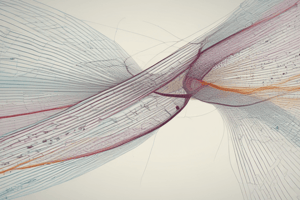Podcast
Questions and Answers
What is a differential equation?
What is a differential equation?
An equation involving differentials or differential coefficients or derivatives.
What is the order of the differential equation $1 + (\frac{dy}{dx})^{3/2} = p\frac{d^2 y}{dx^2}$?
What is the order of the differential equation $1 + (\frac{dy}{dx})^{3/2} = p\frac{d^2 y}{dx^2}$?
Two
What is the degree of a differential equation?
What is the degree of a differential equation?
The degree is the degree of the highest derivative after clearing radicals and fractions.
What is a general solution of a differential equation?
What is a general solution of a differential equation?
What is a particular solution?
What is a particular solution?
What defines a singular solution?
What defines a singular solution?
What is the differential equation of the family of curves represented by $y = Ae^{2x} + Be^{-2x}$?
What is the differential equation of the family of curves represented by $y = Ae^{2x} + Be^{-2x}$?
How do you express the general form of a first order and first degree ordinary differential equation?
How do you express the general form of a first order and first degree ordinary differential equation?
What is the particular form of a first order and first degree ordinary differential equation?
What is the particular form of a first order and first degree ordinary differential equation?
Flashcards are hidden until you start studying
Study Notes
Differential Equations
- An equation involving differentials, differential coefficients, or derivatives is called a differential equation.
- Examples of differential equations include:
- dydx=x+3 \frac{dy}{dx} = x + 3 dxdy=x+3
- d2ydx2+3dydx+2y=0 \frac{d^2y}{dx^2} + 3\frac{dy}{dx} + 2y = 0 dx2d2y+3dxdy+2y=0
- y+xydzdy=k(1+dydx)2 y + xy\frac{dz}{dy} = k\left(1 + \frac{dy}{dx}\right)^2 y+xydydz=k(1+dxdy)2
- p=d2y/dx21+dy/dx p= \frac{d^2y/dx^2}{1+dy/dx}p=1+dy/dxd2y/dx2
- ydydx=xdydx+a y \frac{dy}{dx} = x\frac{dy}{dx} + a ydxdy=xdxdy+a
- Differential equations refer to those equations where all differential coefficients have reference to a single independent variable.
- Partial differential equations contain differential coefficients related to more than one independent variable, which are not discussed here.
Order and Degree of Differential Equations
- The order of a differential equation is determined by the order of the highest derivative appearing in it.
- Example: The order of the equation 1+(dydx)3/2=pd2ydx2 1 + (\frac{dy}{dx})^{3/2} = p\frac{d^2 y}{dx^2}1+(dxdy)3/2=pdx2d2y is two because the highest derivative d2ydx2 \frac{d^2 y}{dx^2} dx2d2y is present.
- The degree of a differential equation corresponds to the degree of the highest derivative in the equation after simplifying it by removing radicals and fractions.
Solutions of Differential Equations
- A solution or integral of a differential equation represents a relationship between the dependent and independent variables, where the derivatives obtained from the relationship satisfy the given equation.
- Example: y=sinx+cy = sin x + cy=sinx+c is a solution of the differential equation dydx=cosx \frac{dy}{dx} = cos xdxdy=cosx.
Kinds of Solutions
- General Solution or the Complete Primitive: The solution of a differential equation containing a number of arbitrary constants equal to the order of the differential equation is called the general solution or the complete primitive.
- Example: y=c1cosx+c2sinxy = c_{1} cos x + c_{2} sinxy=c1cosx+c2sinx is a general solution of the differential equation d2ydx2+y=0 \frac{d^2y}{dx^2} + y = 0 dx2d2y+y=0
- Particular Solution: If particular values are assigned to the arbitrary constants in the general solution, the resulting solution is called the particular solution.
- Example: For the complete primitive y=Acos(x+B) y = A cos (x + B)y=Acos(x+B), when constants AAA and BBB are assigned the specific values 111 and 000, the particular solution is y=cosxy = cos xy=cosx
- Singular Solution: Solutions that cannot be derived from the general solution, even by assigning specific values to the arbitrary constants, are called Singular Solutions.
Examples
- 1.* Find the differential equation of the family of curves y=Ae2x+Be−2xy = Ae^{2x} + Be^{-2x}y=Ae2x+Be−2x, for different values of A and B.
- Solution:
- Start with the equation: y=Ae2x+Be−2xy = Ae^{2x} + Be^{-2x}y=Ae2x+Be−2x
- Differentiate both sides with respect to xxx: dydx=2Ae2x−2Be−2x \frac{dy}{dx} = 2Ae^{2x}-2Be^{-2x}dxdy=2Ae2x−2Be−2x
- Differentiate again: d2ydx2=4Ae2x+4Be−2x=4(Ae2x+Be−2x)=4y \frac{d^2y}{dx^2} = 4Ae^{2x} + 4Be^{-2x} = 4(Ae^{2x} + Be^{-2x}) = 4ydx2d2y=4Ae2x+4Be−2x=4(Ae2x+Be−2x)=4y.
- Therefore, the required differential equation is d2ydx2=4y \frac{d^2y}{dx^2} = 4y dx2d2y=4y
- 2.* Find the differential equation of the system of curves y=ax2+bcosnx+c y=ax^2 + b cos nx + cy=ax2+bcosnx+c, where a, b, c are arbitrary constants.
- Solution:
- We have y=ax2+bcosnx+c y=ax^2+b cos nx+cy=ax2+bcosnx+c.
- Differentiate: dydx=2ax−bnsinnx \frac{dy}{dx} = 2ax - bn sin nxdxdy=2ax−bnsinnx
- Differentiate again: d2ydx2=2a−bn2cosnx \frac{d^2y}{dx^2} = 2a - bn^2 cos nxdx2d2y=2a−bn2cosnx
- Differentiate once more: d3ydx3=bn3sinnx \frac{d^3y}{dx^3} = bn^3 sin nxdx3d3y=bn3sinnx
- Eliminate 'a' between equations (ii) and (iii): x2yd2ydx2−dydx=bn(cosnx−sinnx) x^{2}y\frac{d^2y}{dx^2} - \frac{dy}{dx} = bn(cos nx - sin nx)x2ydx2d2y−dxdy=bn(cosnx−sinnx)
- Eliminate 'b' between equations (iv) and (v) by dividing:
d3ydx3/x2yd2ydx2−dydxx2y \frac{d^3y}{dx^3} / \frac{x^2y\frac{d^2y}{dx^2}-\frac{dy}{dx}}{x^2y}dx3d3y/x2yx2ydx2d2y−dxdy = −x2sinnxcosnx−sinnx \frac{-x^2 sin nx}{cos nx -sin nx}cosnx−sinnx−x2sinnx - This is the required differential equation. Notice that three constants have been eliminated, resulting in a differential equation of the third order.
Exercises
- Find the differential equation from x2−y2+2λxy=1x^2 - y² + 2\lambda xy = 1x2−y2+2λxy=1, where λ is a parameter.
- Determine a differential equation from the equation ax2+by2=1ax^2 + by^2 = 1ax2+by2=1, where a and b are parameters.
- Find the differential equation of all circles of radius r.
- Form the differential equation of all circles of radius r.
- Show that v = A/r + B is a solution of d2vdr2 \frac{d^2v}{dr^2}dr2d2v + 2rdvdr=0 \frac{2}{r}\frac{dv}{dr} = 0r2drdv=0.
- Find the differential equation corresponding to y = ae^2x + be^-3x + ce^x.
Differential Equations of First Order and First Degree
2.1 Equations of the First Order and First Degree
- The general form of an ordinary differential equation of the first order and first degree can be written as M+Ndydx=0M + N \frac{dy}{dx} = 0M+Ndxdy=0, where M and N are functions of x and y, or are constants.
- It can also be expressed as:
- dydx=f(x,y)\frac{dy}{dx} = f(x, y)dxdy=f(x,y)
- (x,y)dy=f(x,y)dx(x, y) dy = f(x, y) dx(x,y)dy=f(x,y)dx
- −f(x,y)dx+(x,y)dy=0-f(x, y) dx + (x, y) dy = 0−f(x,y)dx+(x,y)dy=0
- $M...
Studying That Suits You
Use AI to generate personalized quizzes and flashcards to suit your learning preferences.





